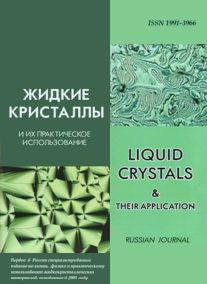|
Menu

|
|
|
|
|
Zhidk. krist. ikh prakt. ispol'z. = Liq. Cryst. and their Appl., 2017, 17 (4), 41—48.
DOI: 10.18083/LCAppl.2017.4.41 |

|
|
Hydrogen-Bonded Complexes of 4,4'-Bipyridyl and its Derivatives with 4-n-Propyloxycinnamic Acid: Structure and Stability
|
N. I. Giricheva1, M. S. Fedorov1, S. A. Surby1, K. E. Shpilevaya2, E. M. Chernova1, M. R. Kiselev3
|
Author affiliations
1Ivanovo State University,
39 Ermak St., Ivanovo, 153025, Russia
E-mail: n.i.giricheva@mail.ru
2Ivanovo State University of Chemical and Technology,
7 Sheremetevsky Ave., Ivanovo, 153000, Russia
3A. N. Frumkin Institute of Physical Chemistry and Electrochemistry of the RAS,
31 Leninsky Pr., Moscow, 119991, Russia
|
|
Abstract
H-bonded complexes A···B(C)···A, where A is 4-n-propyloxycinnamic acid, B is 4,4'-bipyridyl and C is 1,2-bis(4-pyridyl)ethane have been prepared. DSC curves of the studied complexes showed that in the temperature range between Cr → I there are additional maxima that can be attributed to the Cr → LC → I transitions. Thus, the elongation of the core of the supermolecule A···B(C)···A due to the introduction of molecules B or C between molecules A with short substituents can lead to the appearance of LC properties of the system.
The formation of H-complexes was confirmed by IR spectra in which wide bands were observed at 2450 and 1870 cm-1 for the complex A···B···A and at 2400 and 1923 cm-1 for the complex A···C···A.
The quantum-chemical method DFT/B97D/6-311++G** was used to study changes of complexes' properties depending on the nature of the bridge group between two pyridine moieties. In addition to the complexes A···B···A and A···C···A, the complexes A···D···A and A···E···A, where D is 1,2-bis(4-bipyridyl)ethylene, and E is 4,4'-azopyridine, were considered. For all complexes, a geometric structure, parameters of geometric anisotropy, elements of the polarizability tensor and the energy of the hydrogen bond are determined. Due to the anisotropy of electronic and geometric parameters and the high strength of the intermolecular H-bonds the considered complexes are systems capable of exhibiting LC properties. Analysis of the boundary orbitals energies and their differences shows that the complexes should differ significantly in photoelectronic characteristics and oxidizing properties. Thus, the introduction of different bridging groups –CH2–CH2–, –CH=CH–, –N=N– into 4,4'-bipyridyl allows to regulate oxidizing properties of H-complexes and also influence their spectral characteristics.
Keywords: liquid crystals, hydrogen bond, H-complexes, 4-n-alkyloxycinnamic acid, 4,4'-bipyridyl, IR-spectra, quantum chemical calculations
|
|




